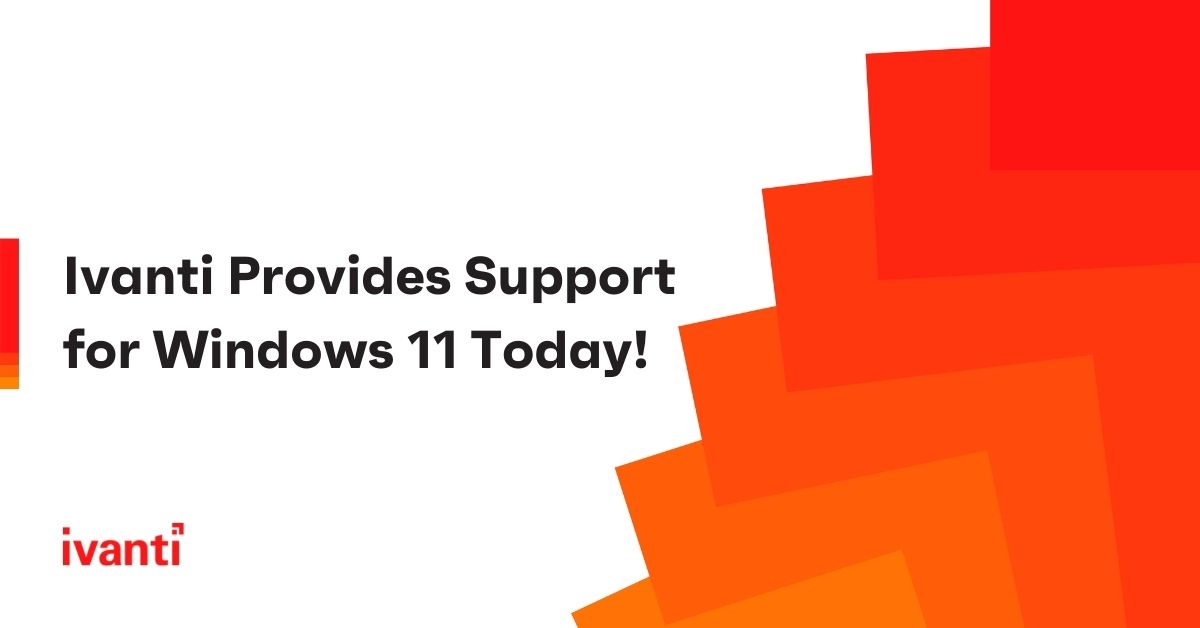Ivanti Provides Support for Windows 11 Today!
Microsoft Windows 11 is now available. In the coming weeks and months, PC vendors will offer an option to purchase a new computer with Windows 10 or Windows 11.
Ivanti UEM solutions provide immediate support of Windows 11, allowing IT to discover, manage, secure and service these devices. Regardless of rolling out Windows 11 day-one or taking your time, Ivanti UEM is ready when you are. Ivanti UEM also makes it easy to identify devices that meet Windows 11 installation requirements and helps control, simplify and automate your Windows 11 rollout.
Ivanti provides a great Windows 11 management experience with the ability to enable you to discover, manage, secure and service Windows 11 devices.
Microsoft will also begin a rollout of notifications to compatible computers running Windows 10 that they are eligible to upgrade to Windows 11. The upgrade is free for the foreseeable future. Fortunately, enterprises can control the notifications and rollout. We are pleased to announce that all Ivanti UEM products are releasing updates this month that fully support Windows 11. You may wonder whether rolling out Windows 11 is right for your company. In this article we will identify the new features and requirements you should consider.
Why consider moving to Windows 11?
There are two main reasons you would consider moving to Windows 11: One is user experience and the other is security. Microsoft has communicated more information about the first than the latter, but it is the latter that IT wants to know more about. We will do our best to cover these topics.
User experience
Windows 11 provides a modern, clean, fresh and beautiful new experience. These aren’t our words. This is how Microsoft describes the new interface and overall user experience. The location and functionality of the Start Menu has changed. The new layout seems to be intuitive to use.
Another new feature is Widgets. This provides a set of mini apps on a translucent lay-over background that slides in from the side of the screen. It functions a lot like the feature that showed up a while ago in Windows 10 near the system tray (the weather symbol that expands into info and news for the day). It saves you from having to pick up your phone to access similar information.
Also new to Windows 11 is Snap layouts. This feature lets you better organize applications and windows by grouping them together. There are several ways to group them in configurations of two, three or four grouped apps.
Other features and changes
Windows 11 introduces the ability to run Android apps on Windows. This is likely a response to Apple’s announcement of being able to run iPhone and iPad apps on macOS. It allows users to run their favorite apps on the platform they are currently on, without having to switch to another hardware device. IT can control whether or not to make this feature available to end users.
The new Windows Store available in Windows 11 will allow running Win32 applications, in addition to Progressive Web Apps and Universal Windows Platform apps.
Say goodbye to Internet Explorer. It is not included in Windows 11, nor is the old Spartan-based Edge browser. Only the new Chromium-based Edge is available and promises many new enhancements.
Another change to note is that Microsoft will provide feature updates to Windows 11 only once per year instead of the bi-annual cadence they had been following. So, expect major updates to Windows 11 to occur annually at this time of the year.
Security
Microsoft states that Windows 11 is designed for better security. I’m sure we will see and hear more about this in the future. For now, this is best illustrated by the requirement for a PC to have Trusted Platform Module (TPM) 2.0 or later, as well as requiring UEFI and Secure Boot capable. Windows 11 also requires a processor from a more modern chip set, namely 1GHz or faster, with two or more cores on a compatible 64-bit processor. The compatible processors are Intel 8th generation or newer, AMD Gen 2 Ryzen or newer, and a number of Qualcomm Snapdragon ARM processors.
